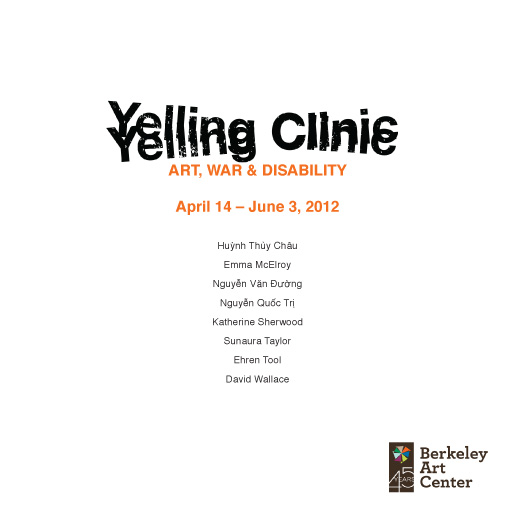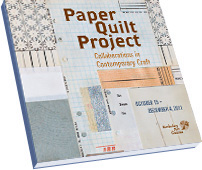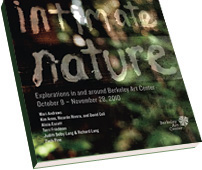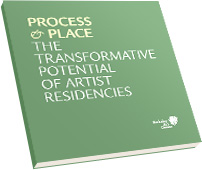
Catalogs of Berkeley Art Center exhibitions, books, calendars, and other printed materials are available from the Center. Prices do not include California sales tax, if applicable, nor shipping & handling. For more information, please e-mail info [at] berkeleyartcenter.org or call 510-644-6893.
Foreward by Suzanne Tan, Introduction by Richard Whittaker, Essay by Nancy M. Servis From the exhibition of the same name, Local Treasures is a handsome document of the exhibition with an illuminating contextual essay by ceramics scholar Nancy M. Servis along with full color photographs of the artists’ work and installation of the exhibition. |
|
Foreward by Suzanne Tan, Introduction by Katherine Sherwood and Sunaura Taylor, Essay by Susan Schweik From the exhibition of the same name, Yelling Clinic: Art, War & Disability is a compelling catalog articulating the work of this visual art collective that focuses their attention on issues related to war and disability. |
|
From the exhibition of the same name, individual artist catalogues feature color reproductions of the artists’ contemplative abstract process paintings, depicting shifting landscapes that move and morph into new territorial dimensions. For many years, Bloomfield, Dillbohner, and Mattes have individually studied ever-changing topographies – investigating geological formations of the earth, observing patterns made by wind and water, and watching the flow of light. Using a variety of materials and techniques, their work delves into the mystery of our often tenuous and fractured relationship with the natural world, exploring both the beauty and the tension that exists in that relationship.
|
Foreward by Suzanne Tan, Introduction by Lena Wolff From the exhibition of the same name, Paper Quilt Project: Collaborations in Contemporary Craft is organized around the idea of collaboration and the democratic folk art phenomenon of quilt making. For the exhibition, 14 artist teams were invited to make works on paper and installations based on the quilt with underlying themes of interdependence and interconnectivity. |
|
Downsize Gazpacho (with reduction of NEA) Just released, a special limited edition print and multiple by Enrique Chagoya in partnership with Electric Works! The brilliant and humorous print and multiple is modeled on Chagoya's wildly popular series of "Cannibull's" soup cans released by Electric Works last year. Downsize Gazpacho (with reduction of NEA) is only available at Berkeley Art Center for a limited time! The digital print is part of an edition of 50 and the multiple is a small edition of 25. The print is available for $250, the multiple is part of the deluxe, two-item set – $500 for both print and multiple. Please contact Berkeley Art Center today at 510-644-6893 to reserve your print or deluxe set! |
|
Foreward by Suzanne Tan, Introduction by Kim Anno From the exhibition of the same name and inspired by Berkeley Art Center’s idyllic setting in Live Oak Park and above Codornices Creek, intimate nature presents a poetic selection of visual art and interactive installations about place, encouraging a closer look at the beauty and fragility of our natural world. Artists include the collaborative team of Kim Anno, Ricardo Rivera, and David Coll; Judith Selby Lang and Richard Lang; Mari Andrews; Alicia Escott; Terri Friedman; and Zach Pine. |
|
|
Produced in conjunction with Berkeley Art Center’s exhibition of the same name. Director/curator Suzanne Tan and artist Elizabeth Sher organized the exhibition and oversaw catalog production. New Pacific Studios director Kay Flavell contributed a major essay. The exhibition examines the notion of place, the nature of retreat, and how that impacts the process of artmaking through an examination of the artists’ own work and experiences. Artists include: Amy Berk, Mary Curtis Ratcliff, Edith Hillinger, Brooke Holve, Anne Lamborn, and Elizabeth Sher. |
|
This catalog is produced in conjunction with Berkeley Art Center’s exhibition of the same name. Co-Curators Michelle Mansour and Jamie Brunson conceived of the exhibition, contributed an essay, and produced the catalog with an introduction by BAC Director Suzanne Tan, and an extensive essay and artists notes from art historian Dr. Mark Levy.
“To celebrate poetry’s vibrant and varied presence [here], the City of Berkeley called on former U.S. poet laureate Robert Hass and award-winning artist David Lance Goines to design a series of poetry panels that have been installed in the sidewalks along Addison Street, in the heart of Berkeley’s downtown arts and theater district. The Berkeley Poetry Walk, designated a National Poetry Landmark by the Academy of American Poets, presents works that range from on Ohlone Indian song fragment…to poems about urban spaces, war, music and of course love.”
The book is a guide to the street panels with their texts as well as brief biographies of their authors.
A large sampling of the quilts of this National Heritage Award-winning African-American artist.
Forty-two artists of such American communities as Japanese, Japanese-American, Chinese, Jewish, African-American, Greek, Italian and Anglo-American are represented in the exhibition. The catalog emphasizes the contributions to American culture of Japanese aesthetic traditions.
Photographers represent the human condition, focusing on identity, aging, and death.
Mildred Howard is one of America’s most distinguished artists. The catalog discusses the themes of the exhibition as well as Howard’s methods and personal background, and it stresses the importance of her work within the context of the art of the African Diaspora.
An exhibition of racist stereotype and caricature from the collection of Janette Faulkner.
Ethnic Notions…must be seen for its painful lessons in the power of images. These insidious articles owe their power not only to an iconography of mockery and derision but also to the fact that so many of them were mass-produced. Particles of toxic propaganda, they pervaded America like fallout from the Civil War and the ineradicable sin of black enslavement that detonated it.
The works of fourteen psychiatrically-challenged and creative people who emerge from isolation through their art.
This catalog of a stunning exhibition at the Berkeley Art Center is appropriately beautiful in and of itself. The design of the book and the color plates within it reflect perfectly Curator Robbin Henderson’s statement in her introduction: “While the [Berkeley Art Center’s] exhibition program tends to focus on emerging artists, BAC’s audience also cherishes presentations of mature artists of exceptional accomplishments who have contributed to and been nurtured by our community. We are proud to offer: Loom & Lathe: The Art of Kay Sekimachi and Bob Stocksdale as a way of fulfilling the Berkeley Art Center’s mission, and in acknowledgement and celebration of two of Berkeley’s cultural treasures.”
2008 is gone. But the poster images, above the calendars themselves, are vibrant, strikingly colorful -- and never out-dated. Each image, approximately 11” x 11”, is of a powerful poster: No Blood for Oil! Boycott Grapes. Trees for Haiti -- twelve images of the tradition of political protest in the United States.
“From the days of the Quaker broadsides against slavery to the current conflict in the Middle East, people have used ink and paper to speak out for peace and justice. . . . [T]his inspiring calendar offers reprints of political action posters, many of them still disturbingly relevant, combined with mission statements on the posters from the original artists.”
Exploration of the sacred and how artists interpret it. The six artists’ diverse backgrounds inform their work and remind the viewer that experiencing the sacred is both universal and unique.
Books by eleven of the foremost artists working in the field of defining the Book as Art.
Ten artists whose genre is primarily the written word but whose work has crossed the boundaries of literature into visual art.
Paintings and installations by eight artists about our most precious resource.
“A marvelously evocative presentation of a stirring, complex, colorful era... which, overall, helped to civilize the society and culture dramatically.” – Noam Chomsky, Professor of Linguistics, Massachusetts Institute of Technology
“The Whole World's Watching brings the Sixties and Seventies alive in a remarkable set of photos and essays. The photos are strikingly dramatic and will recall to those who lived in those years the emotion, the anger, and the joy of participating in the great social movements of our time. The essays are short, pungent, and wide-ranging as they recall the richness, the camaraderie of those historic struggles for peace and justice.” – Howard Zinn, historian and author of A People's History of the United States.






